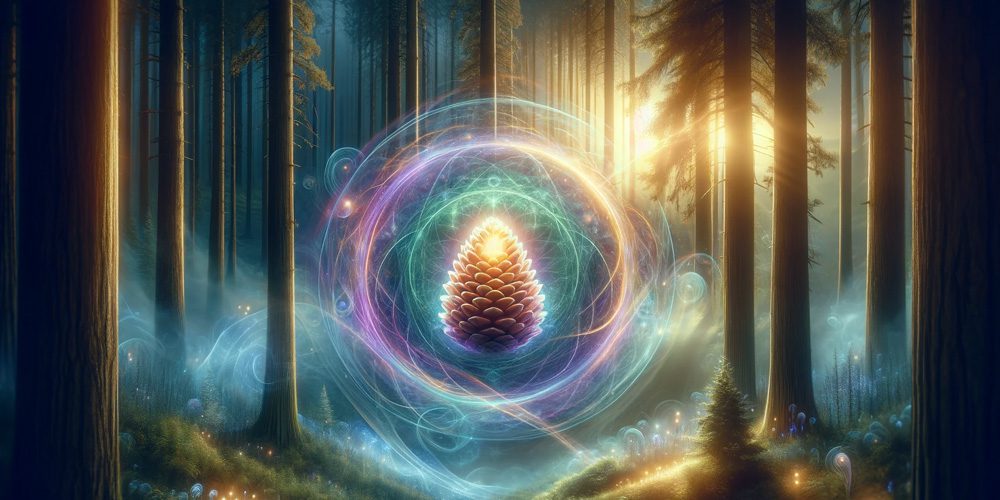There exists within our bodies a mysterious, tiny gland that holds tremendous power. This diminutive organ, nestled comfortably in the center of our brains is known as the pineal gland. Despite its humble size – no larger than a grain of rice – don't be fooled into underestimating it.
The pineal gland has been referred to as ‘the seat of the soul', and has captured the fascination of philosophers, spiritualists, and scientists throughout history. Why such intrigue?
The answer lies in its unique properties and functions which we are still only beginning to explore and understand fully. Our understanding grows with each passing day, illuminating this enigmatic organ's role in our mental, physical and potentially even spiritual well-being.
More Than Meets The Eye: The Role of the Pineal Gland
So what role does this overlooked little dynamo play in our bodies? Primarily, it’s responsible for producing melatonin.
Melatonin is a hormone that controls your sleep cycles or circadian rhythms. Essentially it helps regulate when you get sleepy at night and when you start to wake up in the morning.
But wait! That's not all this petite powerhouse is capable of!
Emerging research suggests that it may also be involved in regulating mood swings, enhancing our creativity levels, influencing sexual development and governing our aging process. Henceforth we might say that this pea-sized wonder plays grandiose roles beyond what its size would suggest.
In many cultures across time, however; a spiritually inclined view sees this gland as something very extraordinary indeed – nothing less than a potential connection point between us humans and realms beyond earthly comprehension: divine worlds, an access door to greater consciousness or even enlightenment itself! The pineal gland may seem insignificant at first glance but scratch the surface, and you'll soon realize that it packs a punch well beyond its weight.
Its functions are as vast as they are fascinating, going far beyond mere regulation of sleep cycles. Our understanding continues to evolve, and while we may not yet grasp the full extent of its power, one thing is clear: this tiny marvel plays a crucial part in our overall well-being.
The Science Behind the Pineal Gland: The Link Between the Pineal Gland and Melatonin
At first glance, it might seem odd to connect the pineal gland—a tiny endocrine organ tucked deep inside our brain—with our sleep patterns. Yet, this humble gland is one of nature's greatest marvels, responsible for producing melatonin, a hormone that plays a pivotal role in our sleep/wake cycle.
The intriguing interplay begins when darkness descends. With nightfall, signals travel from your eyes to your brain indicating the absence of light.
This triggers your pineal gland to convert serotonin—an essential neurotransmitter—into melatonin. Essentially, as we bid goodnight to the sun, our pineal gland springs into action.
For those who burn the midnight oil or consider themselves night owls—here's food for thought. The increased exposure to artificial light after sunset can trick your body into thinking it's still daytime.
This may delay or disrupt melatonin production and consequently affect your bedtime. Interestingly enough, this doesn't mean you should plunge yourself into complete darkness come sunset!
Research suggests that exposure to some types of light during nighttime—like dim red light—may not inhibit melatonin release as much as bright lights or blue lights do. In essence, understanding how this small but potent gland functions can help us appreciate its relevance in maintaining a healthy sleep schedule and overall well-being.
Unveiling How Your Pineal Gland Influences Sleep Patterns and Biological Rhythms
Moving beyond its relationship with melatonin alone, let's dive deeper into how precisely the pineal gland influences our sleep patterns and biological rhythms. The hormone produced by our beloved pineal gland—melatonin—is often referred to as the ‘hormone of darkness'. This isn't due to a propensity for gloom, rather it signifies melatonin's crucial role in managing our circadian rhythms.
These natural, internal processes regulate the sleep-wake cycle and repeat on each rotation of the Earth i.e., every 24 hours. During daylight hours, when light enters your eyes, it signals your brain to halt melatonin production.
As a result, you feel alert and awake. Conversely, when darkness falls and light exposure decreases, melatonin production ramps up again—cueing your body that it's time to wind down and prepare for sleep.
However, our modern-day lives often disrupt this natural rhythm—think late-night screen time or graveyard shifts at work—that can throw off our biological clocks. Consequently, this can lead to an array of issues such as insomnia or excessive daytime sleepiness.
What we need is a renewed respect for our body's natural rhythms. Recognizing and accommodating our brain's fundamental need for light/dark cycles can help us optimize productivity during the day while ensuring restful sleep at night—and your pineal gland plays an extraordinarily pivotal role in this process!
The Key to Cognitive Bliss: Why Activate the Pineal Gland?
Have you ever wondered about unlocking the deepest echelons of your mind, accessing an untapped reservoir of potential? The answer might lie in a tiny, pinecone-shaped gland nestled deep within our brains – the pineal gland. This diminutive organ may appear insignificant, but its influence is anything but.
Activating our pineal gland could offer us a gateway into physical, mental and spiritual benefits that we only dream of. Delving into the physiological benefits first, an active pineal gland plays a crucial role in regulating our sleep cycles.
It's this small powerhouse that produces melatonin – the hormone responsible for regulating our circadian rhythm. A well-functioning pineal gland could be instrumental in combating sleep disorders like insomnia and ensure that we wake up refreshed every single morning.
The activation of the pineal gland has also been linked to enhanced mental clarity and improved concentration levels. It aids in promoting laser-sharp focus and fostering creativity; it allows us to tap into innovative ideas that otherwise lay dormant in the crevices of our minds.
Some even say it can heighten intuition, helping us make better decisions and leading us down more fruitful life paths. On a more spiritual level, many believe an activated pineal gland enables profound meditative experiences and facilitates feelings of euphoria or deep peace.
This often leads to improved psychological health with lower stress levels and better management of anxiety or depression symptoms. But let's not forget about its potential anti-aging properties!
Who wouldn't like to sip from this elixir of life? An active pineal gland may slow down aging by affecting cell rejuvenation processes positively.
Third Eye Awakening: Myths vs Reality
The pineal gland is often dubbed as the ‘Third Eye,' said to be a mystical chakra point residing between your eyebrows offering insight into the unseen world. But what's the reality behind these mystical claims? And more importantly, how much of it is just myth?
First and foremost, let's tackle the concept that opening your third eye allows you to communicate with spiritual entities or attain clairvoyant abilities. While such notions are deeply ingrained in several age-old cultures and spiritual practices, there's a dearth of scientific evidence backing these assertions.
The pineal gland indeed plays a crucial role in our overall well-being but attributing supernatural powers to it might be stretching things too far. However, that does not negate the fact that an activated pineal gland can offer deeper insights and self-awareness.
Many find a heightened sense of intuition when their pineal function improves. You may find yourself more attuned to your instincts or start noticing patterns you'd previously overlooked.
The big question: Can you see into the future once your third eye is active? This brings us back to earth from flights of fantasy!
No scientific study has proven this claim yet. Perhaps what people refer to as ‘seeing into the future' is an enhanced intuitive understanding or perception rather than literal precognition.
While we're on myth-busting duty – no, an active pineal gland won't make you levitate or teleport! But hey, wouldn't life be a whole lot easier if it did?
In reality, activating your pineal gland could significantly improve your overall quality of life. It promises healthier sleep patterns, improved focus and concentration levels, enhanced creativity and intuition – all leading down the path towards better mental well-being.
Factors That May Inhibit Pineal Gland Function
Everyday Villains: Fluoride, Caffeine, and Other Culprits
The pineal gland, despite its diminutive size, is an incredibly sensitive organ that can easily be affected by a variety of external factors. One such common villain is fluoride.
You may know fluoride as that substance in your toothpaste that helps fight cavities – but did you know it could potentially be inhibiting your pineal gland function? Upon ingestion, fluoride tends to collect in the pineal gland leading to a condition known as ‘fluorosis'.
This accumulation can lead to calcification of the gland and hamper its ability to produce melatonin effectively. Moving on to caffeine – yes, that much-needed cup of morning joe may not be doing favors for your pineal gland.
Caffeine disrupts our sleep patterns by blocking adenosine receptors in our brain which promote sleepiness. This disruption can cause the pineal gland's production of melatonin to go haywire.
While moderate consumption may not cause significant harm, it's worth being cognizant of these effects. Few are aware that alcohol and tobacco also pose threats to the health of our pineal glands.
Alcohol messes with our biological clock or circadian rhythm by altering levels of our sleep-inducing hormone melatonin. As for tobacco smoke, it introduces toxins into our system that can build up in the bloodstream and eventually affect various organs including the pineal gland.
Besides these, certain medications like sleeping pills or beta-blockers might also interfere with melatonin secretion from the pineal gland due to their sedative properties or their influence on hormones respectively. It's important therefore to acknowledge these everyday villains lurking around us and understand their potential impact on something as significant yet overlooked as our pineal gland.
How Lifestyle Choices Can Impact Your Pineal Gland
Moving beyond dietary factors, our broader lifestyle choices can also greatly impact the health and function of the pineal gland. Let's start with something we all love – sleep!
Lack of quality sleep or irregular sleeping patterns can seriously affect the functioning of the pineal gland. This is because it strictly follows our body's circadian rhythm, releasing melatonin when it gets dark to prepare us for sleep.
Then comes physical activity, which significantly influences our hormonal balance. Regular exercise is known to boost serotonin production during daytime.
As night falls and light decreases, this serotonin is converted into melatonin in the pineal gland – helping us fall asleep easier and better! Stress too plays a major role in disrupting pineal gland function.
Chronic stress leads to elevated cortisol levels which can suppress melatonin production – leading to sleep disorders and other related issues. Apart from these, exposure to artificial light especially during nighttime (like those emitted by your electronic devices) can confuse your biological clock and consequently disturb your pineal gland function.
This phenomenon known as ‘Light Pollution' has become a rather prevalent issue in today's digital age. Our lifestyle choices have a far-reaching influence on various aspects of our health including that little pea-sized organ nestled deep within our brains – the mighty yet vulnerable ‘pineal gland'.
The Edible Elixirs: Diet for a Vibrant Pineal Gland
When it comes to diet, certain foods have been shown to support the health of your pineal gland. Consuming a variety of dark leafy greens such as spinach, kale, and spirulina can help because they are rich in chlorophyll, which has purifying properties that promote optimal function.
Additionally, consuming noni fruit, garlic and raw cacao can be beneficial due to their detoxifying effects. Adequate hydration is also crucial for maintaining glandular health; however, it's ideal to consume filtered or spring water as tap water often contains fluoride which may inhibit pineal activity.
Avoiding certain foods is equally important. Processed foods laden with preservatives and additives should be minimized as these can lead to calcification of the pineal gland.
Excess sugar and artificial sweeteners also fall into this category. It's best to lean towards an organic diet where possible, reducing the intake of pesticide-treated products.
In essence, a clean diet that prioritizes natural produce can contribute significantly towards maintaining a healthy and active pineal gland. Nourishing your body in this way will not only help this tiny gland but will also support overall wellness.
Mindful Meditations: Unleashing the Potential of Your Pineal Gland
Meditation has long been recognized for its ability to stimulate brain activity and enhance focus. When practiced correctly, various meditation techniques can activate the pineal gland too.
One effective practice is Trataka (also called Fixed Gaze Meditation). This involves staring at a single point such as a candle flame without blinking for set intervals; gradually increasing over time.
Another approach centers around visualization methods where you imagine an indigo sphere or light at your third eye during meditation sessions. The power of visualization can aid in ‘waking up' your pineal gland.
This requires consistency and practice but can reap incredible benefits over time. Practicing Chakra meditation, specifically focusing on the third eye or Anja chakra, can also stimulate pineal activity.
This involves deep breathing while visualizing energy flow towards the third eye region. These techniques not only contribute to an activated pineal gland but also promote overall brain health and mental clarity.
Sun Gazing: Shedding Light on An Ancient Practice
Sun gazing is an ancient practice believed to stimulate and activate the pineal gland. Ancient Egyptians referred to the pineal gland as a “solar receptor” and sun gazing as a method of “harvesting solar energy”. Before you rush off to stare at the sun, it's crucial to understand safe methods for sun gazing.
The safest way involves doing it during either the first hour of sunrise or the last hour of sunset when UV levels are lowest. It's recommended that you start slowly, with just 10 seconds on your first day, gradually increasing by 10 seconds each subsequent day.
While there's limited scientific evidence supporting sun gazing as a means for activating your pineal gland, practitioners claim improved mood, increased energy levels and enhanced intuition amongst other benefits. As with any new practice, it's important to do thorough research beforehand and listen to your body’s responses throughout.
Exercises for Activating the Pineal Gland
The Sublime Influence of Breathing
The breath is an incredibly powerful tool. It bridges the gap between the conscious and unconscious mind, acting as a steady rhythm that guides our lives.
Breathing exercises, therefore, form an integral part of activating our pineal gland. Deep breathing exercises have been proven to reduce stress, increase alertness and aid in detoxification.
This is because deep breathing encourages full oxygen exchange — that is, the beneficial trade of incoming oxygen for outgoing carbon dioxide. Not only does this slow the heartbeat and stabilize blood pressure, but it also encourages increased blood flow to all parts of the body including our tiny powerhouse – the pineal gland.
One such exercise you might engage in is alternate nostril breathing or Anulom Vilom. This yogic practice engenders calmness, helps purge negative emotions from your mind and paves the way for enhanced concentration which can stimulate your ‘Third Eye'.
Following a simple routine of inhaling through one nostril while keeping the other closed using your fingers and then alternating can create a sense of balance and serenity. Another effective method is focused breathing wherein you mentally keep track of each breath while visualizing it as light energy entering your brain with every inhale, stimulating your pineal gland.
With each exhale you release negativity allowing room for positive energy to thrive within. And then there’s rhythmic breathing – slow controlled inhalation followed by even slower exhalation establishes a harmonious rhythm in your body which can be conducive to unlocking dormant powers of your ‘Third Eye'.
The Artful Dance of Yoga Postures
Yoga provides some magical postures that are believed to help activate our pineal gland through the sheer power of physical movements coupled with heightened awareness. The first on this list is Balasana or Child Pose.
This restful pose has been known to relieve stress and fatigue, conditions that often hamper the functioning of your pineal gland. In this pose, your forehead touches the ground amplifying blood flow to the head.
Then you have Sirsasana or Headstand which is often referred to as the king of all asanas. As daunting as it may seem initially, regular practice under proper guidance can lead you to execute it with grace and ease.
The inversion increases blood flow directly towards your brain thereby increasing oxygen supply and nourishing your pineal gland. The third yoga pose that aids in activation is Dolphin Pose or Ardha Pincha Mayurasana.
This pose opens up the chest and lungs while improving circulation to the upper body, including our little endocrine hero – the pineal gland. It also invites peace into our minds, preparing a fertile ground for meditation.
Savasana or Corpse Pose might appear deceptively simple but holds within its folds immense rejuvenation for both body and mind. It helps soothe the nervous system, encourages deep introspection and provides an opportunity for self-exploration leading you closer toward ‘Third Eye' awakening.
Last but not least comes Chakrasana or Wheel Pose that stimulates three critical chakras within us – Muladhara at the base of the spine; Ajna located between eyebrows (seat of the ‘Third Eye'); Sahasrara at the crown of the head connecting us with universal consciousness. Regular practice can boost energy flow through these chakras enhancing spiritual growth.
Essential Oils & Herbs for Pineal Gland Health
An Aromatic Journey to Wellness: Essential Oils for Your Pineal Gland
The efficacy of essential oils in holistic wellness is irrefutable. Navigating through the plethora of options can be a bit daunting, but fear not, we'll guide you on this aromatic journey. Lavender and frankincense are two oils that have received accolades for their potential to stimulate the pineal gland.
Lavender, known as the queen of essential oils, can do more than just lull you into a tranquil slumber. It's believed that its calming properties can help relax the mind and facilitate a state conducive to meditation – a key practice in activating our pineal function.
Its vibrant aroma seeping into your senses can prepare your body and mind for a deep spiritual experience. Frankincense, on the other hand, is often associated with spirituality due to its extensive use in religious ceremonies across cultures.
This oil is purportedly beneficial in opening up your third eye by creating an environment of peace within you. When diffused or applied topically during meditation or before bedtime, frankincense aids in attaining an elevated state of consciousness.
Other noteworthy mentions include sandalwood and clary sage – oils revered for their potential role in enhancing spiritual receptivity. Breathing these fragrant substances infuses serenity within us and prepares our bodies for an immersive journey toward higher awareness.
These potent extracts from Mother Nature offer us an easy way to foster our body's harmony while simultaneously promoting pineal gland health. Remember always to purchase high-quality therapeutic-grade essential oils and use them with caution; they are powerful allies on this path of awakening.
Herbal Teas That Soothe & Stimulate: An Infusion of Wellness
Herbal teas have been trusted companions for centuries, comforting us through cold winter nights and serving as our healthful potions. Certain teas have a unique capacity to stimulate the pineal gland while soothing our senses. Chaga mushroom tea, packed with antioxidants, works wonders on your mind and body.
Renowned for its immune-boosting properties, it's also believed to decalcify the pineal gland, enhancing its functionality. Gotu kola tea is another power-packed brew worthy of mention.
Known for promoting brain health, this remarkable herb actively stimulates the pineal gland. It’s a popular choice in Ayurvedic medicine for its potential to heighten spiritual consciousness.
Holy basil or Tulsi tea is not just a sacred plant in India but also revered globally as an adaptogenic herb – assisting the body in adapting to stress. Its soothing properties can pave the way for effective meditation by calming the mind.
Cilantro is another everyday herb that holds potential benefits for our pineal gland when consumed as a tea. It's claimed to help detoxify this little powerhouse organ from heavy metals like fluoride – a common antagonist known to calcify and inhibit the gland's function.
Integrating these herbal infusions into your daily routine can foster tranquility within while subtly stimulating your pineal gland. Remember, these practices are meant as adjuncts on your journey towards awakening – supporting and enhancing other mindful habits such as meditation and consumption of nutrient-rich foods.
Impact of Sound Frequencies on Pineal Activation
Harmonize with Healing: An Introduction to Binaural Beats
The world of sound therapy has garnered significant attention in recent years and one such sonic tool that reigns supreme is binaural beats. These are auditory illusions that occur when you hear different frequency sounds in each ear. The brain bridges the gap, creating a third, internal sound that is perceived but not actually there.
This phenomenon was discovered in the early 19th century and has been utilized for a variety of purposes ever since. Delving deeper, we realize binaural beats operate on the principle of ‘brainwave entrainment'.
This basically means they synchronize with our brain's natural frequencies, thus influencing its state of consciousness. Studies have shown that particular frequencies can impact sleep patterns, promote relaxation, enhance creativity or even stimulate an altered state of consciousness.
Regarding pineal gland activation specifically, theta wave binaural beats—which typically range from 4-8 Hz—are often recommended. Theta waves are associated with deep relaxation and meditation, REM sleep and dreaming states—basically all realms where your pineal gland takes center stage!
By tuning into these frequencies via binaural beats, you could potentially encourage greater activity in your pineal gland. Several apps and websites offer a wide selection of binaural beats tailored to various needs.
Don’t forget to wear headphones as the effects are best experienced this way! Remember also to start slowly—allow your body and mind time to adjust before diving into longer sessions.
Ritualistic Resonance: The Power of Chanting
Another fascinating realm where sound intersects with spirituality is chanting or mantra repetition. Rooted in ancient traditions across cultures worldwide—from Gregorian monks to Indian yogis—chanting holds an esteemed place within spiritual practices for invoking mindfulness and inner peace. But how does this relate to your pineal gland, you ask?
Well, the repetitive sounds and vibrations created during chanting can stimulate the pineal gland. Specific chants or mantras are believed to vibrate at frequencies that resonate with this gland, thus increasing its activity.
‘Om' or ‘Aum', the universal sound in Hinduism and Buddhism, is often associated with the third eye chakra linked to our pineal gland. Regular practice of chanting this mantra is said not only to activate our third eye but also to enhance our intuition and spiritual awareness.
Remember though that it's not just about mindlessly repeating words—it's more about feeling the vibrations permeate through your being and syncing with your breath. So find a quiet space, free from interruptions and allow yourself to explore these ancient practices at your own pace.
Conclusively Clear
By illuminating these diverse methods—be they dietary adjustments, meditative practices, yoga postures or exploring sound frequencies—we've journeyed together in understanding how we might awaken our often ignored but profoundly potent pineal glands. While there’s so much more left unsaid on this labyrinthine subject matter that straddles science, wellness and spirituality—the hope is that you've found a spark of inspiration here—a glimmer of curiosity that nudges you towards further exploration. Here's to unearthing more knowledge on our shared quest for wholeness—invigorating body, mind and spirit in synchrony!
















